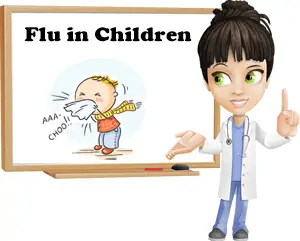October is officially flu season and the start of the epidemic all throughout the Northern hemisphere. And one of the categories most at risk for catching the flu as well as experiencing complications from it are children. Being of school age and spending a lot of time in closed quarters increases the chances of kids getting sick. At their age, children do no master the art of frequent hand washing either and share personal object all the time which increases their chances of developing the respiratory infection.
Furthermore, their immune systems may not be fully equipped to deal with the flu in all its glory, especially if the causative agent is a more virulent strain of the influenza virus (most commonly strains of influenza A or B). All of these factors combined are the main reason for the flu in children and associated complications, whether ear and sinus infections, pneumonia or complications from pre-existing conditions such as asthma, heart or lung conditions, diabetes, immunodeficiency and others.

Do you know how to recognize the flu in children?
Influenza in a child is actually not necessarily something you may pick up on very early on, unless you’ve already dealt with it before and know just how it affects your child. On the one hand, small children are too young to tell what’s wrong and sometimes cannot clearly identify where it hurts. What they do know is that they are not feeling that great. If it’s flu season and your child seems off, is not in the best of moods (which is unlike them) or is simply not feeling like their usual self, losses appetite or lets out a sneeze or two, then it’d be a good idea to keep an eye on them and for upcoming symptoms.
1) Fever. Flu symptoms in children often start out with high fevers (can easily reach 103-105 degrees Fahrenheit or the approximate equivalent of 39.5-40.5 degrees Celsius). The important thing is that the fever not last more than 3-4 days. You should also see temporary improvement in the child’s condition (spirits) after he or she receives antipyretic medication. Fever may alternate with chills and shivering.
2) Headaches. While they don’t occur every time with the flu, headaches are common even in children, likely brought on by high fevers. They may also be accompanied by light sensitivity which causes eyes to hurt in bright light.
3) Aches and pains. Muscle aches, joint pain are common in children with the flu. However, small children and even some older ones may not be able to correctly identify this symptom. If they tell you they don’t feel good, it may very well be because of flu-associated aches.
4) Tiredness. Likely to present itself before other more telling symptoms such as a sore throat or coughing. Is a result of the immune system fighting the virus and can be accentuated by a high fever, dehydration and refusal to feed.

5) Sneezing. Although not very common, a couple of sneezes here and there are a sign to be on the lookout for the flu this season.
6) Coughing and chest discomfort. Likely to be a dry cough, with little to no mucus. It may start out as occasional bouts of coughing, then evolve to a more serious cough that could interfere with sleeping and eating. Can last anywhere from 7-10 days to 2-4 weeks. Chest discomfort can be mild to severe.
7) Nasal congestion. Fairly common with the flu, both in kids and adults. What may look like a runny nose at first can soon turn into stuffiness. Nasal congestion in children causes difficulty breathing through the nose and may encourage mouth breathing which can worsen throat problems.
8) Sore throat. Redness, soreness, pain when swallowing food or saliva can discourage eating and drinking and predispose to dehydration. Refusal to eat and drink can prolong the flu in children and delay recovery.
Atypical symptoms of flu in children
These include nausea, vomiting, diarrhea and associated stomach discomfort and abdominal cramps. These are symptoms typical of a bacterial or viral gastroenteritis (colloquially known as a stomach bug) but are known to occur in children with influenza as well. Vomiting and diarrhea can make a child refuse to eat and drink and accentuate dehydration, becoming a source of complications. Considering gastroenteritis and influenza symptoms overlap and children are more susceptible to dehydration and complications, it’s advised to see a doctor. Find out more about gastroenteritis types, causes, symptoms and treatment.
And here are some important questions to help you better understand influenza in children:
1) How long does the flu last in children? Kids typically recover in a week from the flu, but may need up to 2-4 weeks to regain their energy and vitality and get back to their normal selves. Some symptoms may require up to 2-4 weeks to clear.
2) How long does fever last in children with the flu? Fever in children with influenza lasts, on average, for 2-4 days. Anything beyond requires medical attention. Also, fever should break after a child receives antipyretic medication – if it doesn’t, then take them to the doctor.
3) When is fever too high in children with the flu? Numbers are not completely reliable and vary with age. For example, babies and small children have a much lower threshold for fever than older children. Most medical doctors agree that 100.4 degrees Fahrenheit (38 degrees Celsius) is a dangerous fever in babies. For babies older than 3-4 months and children up to 3 years old, 102.2 degrees Fahrenheit (39 degrees Celsius) is a dangerously high fever.
What you need to look out for is how the child feels. If they are responsive and want to play, eat and drink, then they are likely okay despite the fever. If however they are unresponsive, lethargic, refuse to eat and drink, then it’s imperative they be seen by a doctor as soon as possible.
4) How long do tiredness and coughing last? If they’ve had the flu, expect kids to take some time to recover and get back to their normal, energetic selves. Some kids make a full recovery after 7-10 days, while others may still experience occasional bouts of tiredness and even coughing for up to 4 weeks.
Treatment for the flu in children includes symptoms management therapies such as
1) Ibuprofen or paracetamol for fever, but never aspirin. Some children may not tolerate paracetamol either so if you see them feeling unwell or worse, discontinue it and get them to a doctor. Remember that dosage should be adapted to the child’s age.
2) Plenty of liquids to combat dehydration and nasal congestion (water, either plain or flavored with fruits, fruit juices, vegetable juices etc.).
3) Saline solution sprays for stuffiness. Kids should not be given regular nasal decongestants (and adults are better off without them too). See the long list of side effects of nasal decongestants and alternative remedies to combat stuffiness.
4) Baby nasal aspirators or nasal bulbs, to clear mucus and relieve nasal congestion.
5) Rest to allow the body to fight the infection and conserve energy and strength.
6) Good nutrition. Chicken soup has anti-inflammatory properties. Protein in general helps build up the immune system. Fresh fruits help restore appetite (apples, pears, peaches, apricots, watermelon, oranges etc.) whilst boiled or steamed vegetables are easy to digest.
The child’s doctor should offer more information and personalized advice so don’t hesitate to call on them.
Red flags to look out for (and which warrant immediate medical attention):
1) Fever that doesn’t break even with antipyretic medication or after 2-4 days or causes visible and significant behavioral changes.
2) Refusal to eat and drink liquids.
3) Dehydration signs: dry eyes, dry diapers, infrequent and low urine output and dark urine colors. See urine colors meaning.
4) Wheezing and other lung sounds and breathing difficulties – possible signs of complications or secondary infections (example: pneumonia).
5) Ear aches or sensitivity – may be because of mucus building up and clogging the sinuses or a sign of an infection.
6) Skin that turns blue, purple or gray – seek medical help immediately!
7) Severe cough that doesn’t break or worsens to the point it interferes with eating and resting.
(Do not give cough medicine without consulting with a doctor first and never to a child younger than 6.)
8) Lethargy, confusion, seizures or loss of consciousness, fainting. See more on flu and fainting.
9) See a doctor if the child recovers but relapses.
Prevention:
There’s only so much a parent or caregiver can do to prevent a respiratory infection as contagious as this one, especially considering influenza season lasts 5-6 months a year. At most, you can:
1) Teach the child to always wash their hands before eating.
2) Teach them to avoid putting their hands into their mouth or touching their face.
3) Keep them home if there is an epidemic at school and practice good hygiene if there’s one in the house.
4) Vaccination before the start of the flu season helps prevent frequent and severe respiratory infections.
